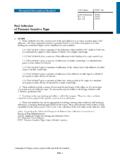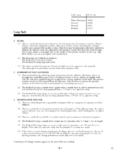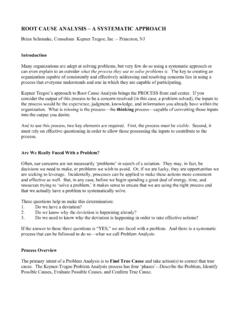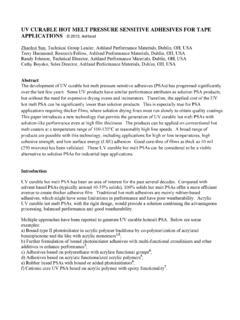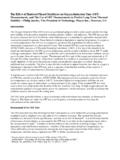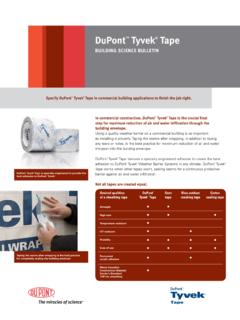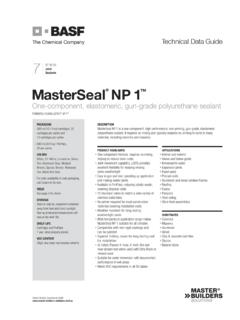Transcription of ADHESION PROPERTIES OF CROSS-LINKED POLYOLEFIN …
1 ADHESION PROPERTIES OF CROSS-LINKED POLYOLEFIN FOAMS Michael J. Pawlisheck, Research & Development Laboratory Manager, Sekisui Voltek, LLC, Lawrence, MA Introduction CROSS-LINKED POLYOLEFIN (XLPO) foams have been used as Pressure Sensitive Adhesive (PSA) substrates for more than 45 years. These XLPO foam substrates can range in density, thickness, and formulation. This paper will show how each of these PROPERTIES affects peel ADHESION using a solvent based PSA double faced tape on XLPO foam with and without Corona Treatment. Common testing would usually require foam failure to demonstrate an acceptable bond between the PSA and the XLPO foam surface. It can, however, be reasonably assumed that higher density thinner XLPO foams would be stronger than lower density thicker XLPO foams. This paper explores peel ADHESION strength of XLPO foam, just prior to foam failure. Experimental XLPO foam, ranging in density from 4 to 12 , primarily 4 pcf was used to generate the data contained in the paper.
2 Thickness ranged from to , with a primary thickness of . The base resin that was used was Ethylene Vinyl Acetate (EVA) with a Vinyl Acetate (VA) range of 0% to 12%, with a primary content of 12%. The impact of XLPO foam age with an alternative formulation was also examined. Table 1. XLPO Foam PROPERTIES Property Range Typical Density ( ) 4 to 12 4 Thickness (inches) to Ethylene Vinyl Acetate (VA content %) 0 to 12 12 Solvent based Acrylic Pressure Sensitive Adhesive (PSA) Double faced tape of 130 micron thickness was used for all testing. Sample Preparation Samples of XLPO foam were collected and identified by density, VA content , thickness, and formulation differences, if any. The XLPO foam sample was generally 12 x 12 x thickness. Samples were tested as is (UT), and after corona treatment (CT) to a target surface energy level of 42 dynes/cm. PSA double faced tape was applied to the test surface of the XLPO foam with light pressure.
3 The non-test surface of the foam was reinforced with PET PSA tape. This reinforcement was required to mitigate the inherent extensibility of XLPO foams. The XLPO foam samples with PSA and reinforcement were die cut into 1 x 12 strips. The release liner was removed from the PSA double faced tape, which was then applied to stainless steel plates with light pressure. All samples were conditioned for 17 24 hours. Test Method Table 2. Test Method Summary Condition 90 Degree 180 Degree Sample Width 1 inch 1 inch Roll Weight/Mass lbs. lbs. Roller Surface Rubber Rubber Rolldown Rate 12 12 Number of Roll (each direction) 1 1 Dwell time 20 minutes 20 minutes Substrate Material1 XLPO Foam XLPO Foam Temperature 70 +/- 2oF 70 +/- 2oF Humidity 50 +/- 5% RH 50 +/- 5% RH peel Rate 17 inch/min 12 inch/min Test Result (units) 1 Typical ADHESION testing would require the removal of a PSA from Stainless Steel with a known surface texture.
4 For the purposes of this paper the XLPO foam was removed from the PSA tape without tearing the foam, as shown in Appendix 1. Equipment Used Below are photographs of the primary equipment used to generate the data presented in this paper. Figure 1. Slip/ peel Tester Figure 2. Corona Treater XLPO Manufacturing Process Figure 3. Blending & Extrusion Figure 4. Irradiation Figure 5. Foaming Figure 3. The first step of the manufacturing process for XLPO foams starts with the blending and extrusion of POLYOLEFIN resin with a chemical foaming agent, additives and colorants. This blend is shaped into a flat sheet that determines the final thickness and density. Figure 4. The second step of the process is irradiation. In this step the extruded sheet is exposed to ionizing irradiation, which cross links the POLYOLEFIN resin. There is no apparent change in the extruded sheet. Figure 5. The last step in the process is the expansion of the cross linked extruded sheet into a cellular product.
5 This is accomplished in vertical oven with the combination of hot air and infrared heat. Once the sheet has expanded, the XLPO foam is cooled and the edges are trimmed and rolls are produced. Results Impact of Density on ADHESION Graph 1 Graph 2 Graph 3 Graph 4 Density has both a positive (increase) and negative (decrease) effect on the ADHESION strength of XLPO foams. The positive or negative effect is influenced by the angle that it is tested at and whether there is Vinyl Acetate present in the foam. The largest increase is seen at 180o degree peel for 12 % VA content foam and the largest decrease is seen at 90o degree peel for 0% VA content . Impact of Thickness Graph 5 Graph 6 Thickness has little impact on the ADHESION of 12% VA content XLPO, when tested at 180 degrees, and a small increase at 90 degrees. It is expected that without the foam tearing, the peel strength would be unaffected by thickness.
6 Vinyl Acetate content Graph 7 Graph 8 Graph 9 Graph 10 It was assumed that higher VA content XLPO foams, which are a more flexible substrate, would show an increase in peel ADHESION as the VA content increased. In fact this assumption was incorrect. As the VA content increased the ADHESION decreased. Impact of Age Graph 11 Graph 12 Graph 13 Graph 14 Graph 15 Graph 16 Graphs 11 through 14 show the impact of formulation on 9% VA content XLPO foam as the material ages. For this testing PSA was applied to aged XLPO foam. It is clear that ADHESION strength decreases over time. Graphs 11 and 12 are for untreated XLPO foam and Graphs 13 and 14 are for corona treated XLPO foam. These graphs also show that Formula # 1 starts with lower ADHESION and remains lower than Formula # 2. Graphs 15 and 16 show that 12% VA content foam also loses ADHESION , but still can be corona treated in the laboratory to achieve high ADHESION .
7 Discussion It should be noted that corona treating was performed to achieve a target surface energy of 42 dynes/cm. Each individual treatment was targeted at a Watt Density of kW/m2/min. Fresh material generally required two passes at that power level to achieve 42 dynes/cm. Aged material required, on average six times the number of passes to achieve 42 dynes/cm. This, of course, would be unacceptable in a manufacturing environment. Most of the 90 degree test results of each sample were higher than the corresponding 180 degree sample. This is due to the rate of testing. Each 90 degree test is performed at 17 /minute whereas the 180 degree test is performed at 12 /minute for an effective rate of separation of 6 /minute. Conclusions Density has the greatest impact on ADHESION of XLPO foams that contain Vinyl Acetate. Thickness, under the conditions of this paper, has no meaningful impact on ADHESION .
8 XLPO foam exhibits lower ADHESION as the VA content increases. Formulation has an impact on ADHESION as the XLPO foam ages. Corona treating improves the ADHESION characteristics of XLPO foam in all circumstances. Both 90 and 180 degree testing should be used to evaluate the ADHESION characteristics of XLPO foams. Appendix 1 Below are two pictures of the type of failure that can be encountered when testing XLPO foam substrates. Picture # 1 is the type that was used to generate the data for this paper; the foam was removed from the PSA without failing. Picture # 2, while demonstrating a very good bond between the PSA tape and the foam, it does not provide quantitative data about the adhesive bond; the foam failed. Picture 1. Acceptable Picture 2. Unacceptable Foam Failure Acknowledgements The author would like to thank Nancy Spicer from Sekisui Products for providing the Double Faced PSA tape that was used for all testing.
9 In addition, Hiro Murayama, Anh Le, Luan Pham, Christina Muth and Cory Lavallee, of Sekisui Voltek, LLC contributed to this paper.

